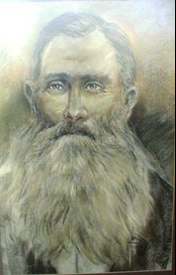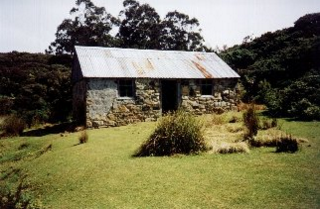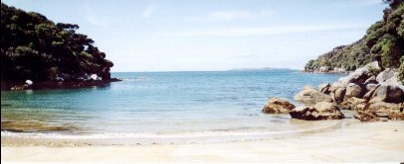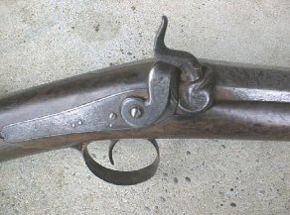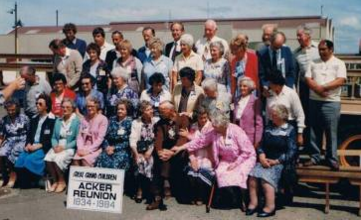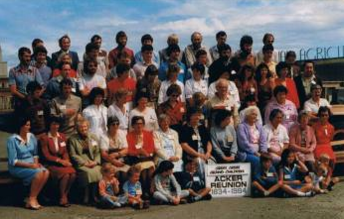Lewis Acker
Born Charleston, New York, c 1815
Whaler, settler, boat builder,pilot, captain, landowner, saw miller, trader
Whaler, settler, boat builder,pilot, captain, landowner, saw miller, trader
|
Lewis Acker was born the son of a mariner and landowner in New England, America, around the year 1815. His family possessed a large estate in New York but society life was not for Lewis and his family agreed that he could go to sea, in the hope that it might teach the boy some discipline and put a stop to his wild behaviour. Perhaps they thought after a few years of shipboard life he would have learned enough to return to land where he could work hard to establish a respectable life, earn a good living, and find a suitable wife to start his own family.
That Lewis actually did all of this, the Acker family most likely never knew. Lewis's son Oliver commented many years later that his father rarely ever spoke of his family in America. Oliver's impression of the family he never knew was one of strictness and conventionality and he doubted his father had ever even written to let them know he was still alive. It was only while in the company of ship captains and travellers that Lewis would enquire if they were familiar with the Acker family of New York. Sadly, history repeated itself thirty years later when Lewis's son William left New Zealand and was never heard from again. |
Lewis Acker's first visit to New Zealand was as a 16 year old onboard the whaler Hibernia (1) working off the islands in the deep south during the summer of 1832/1833. In 1830, when Captain Benjamin Morrell arrived back in America from the Auckland Islands on his schooner Antarctic, he reported seeing very few seals left alive. Despite this, the trade continued and American whaleship masters sometimes employed their crew in it between taking whales from the fisheries. Lewis Acker's vessel worked the waters around Auckland Islands before calling at Dusky Bay in the south-west corner of New Zealand's South Island. Here, the ship's carpenters carried out repairs in preparation for a long voyage home. Dusky Bay had become a favourite anchorage for explorers, sealers, and whalers since Cook's first visit to New Zealand, and it remains as remote today, accessible only by sea or foot.
Lewis's second visit to New Zealand occurred the following season when his whale ship returned from America to the south sea fisheries. On this occasion they were based at Bluff Harbour, a growing haven for visiting American whalers. James Spencer had established a hospitable little community at the Bluff and his home come pub presented a warm welcome with grog flowing and fiddles playing. During their stay, Lewis Acker took an exploratory trip along the coast with a boat's crew. Adrift in the strait in the darkness of night they lost their bearings and eventually made it onto an island where they were able to rest until morning. As the day dawned the party realised they were at the mouth of a large river. Lewis lead his men up the river which he named New River, a name it kept for many years before reverting to its Maori title, Oreti. Lewis Acker's ship and crew set up a small station at Otatara to work from while they were employed in that part of Foveaux Strait.
The time spent along the shore and on the islands in the south must have been agreeable to Lewis Acker. For rather than sail back to America where his family were awaiting his return, he sought clearance to disembark in Sydney. Men that chose to leave their ships were making a bold decision to become independent in every sense. From their families, their backgrounds, cultures, employers and even from their countries.
In 1835 the waters off the coast of the South Island were busy. Johnny Jones' Sydney Packet criss-crossed the Tasman with supplies for and cargo from his newly acquired Preservation Station. Captain Anglem was another frequent visitor, master first of Caroline and then Lucy Ann, and when the Weller Brothers had their whaling station in Otago, the locally built Joseph Weller. Many other vessels called at the small stations that had sprung up along the coast. All of these vessels sailed frequently between the South Island and Sydney bringing provisions, whaling crews, trading goods and often disease. In 1834, measles had claimed the life of the south's paramount chief Te Whakataupuka. Tuhawaiki, known as Bloody Jack to the Europeans, became the new leader at a time when Maori and European intergration increased significantly. It was from this chief that Lewis Acker purchased 600 acres of land on Stewart Island.
Lewis's second visit to New Zealand occurred the following season when his whale ship returned from America to the south sea fisheries. On this occasion they were based at Bluff Harbour, a growing haven for visiting American whalers. James Spencer had established a hospitable little community at the Bluff and his home come pub presented a warm welcome with grog flowing and fiddles playing. During their stay, Lewis Acker took an exploratory trip along the coast with a boat's crew. Adrift in the strait in the darkness of night they lost their bearings and eventually made it onto an island where they were able to rest until morning. As the day dawned the party realised they were at the mouth of a large river. Lewis lead his men up the river which he named New River, a name it kept for many years before reverting to its Maori title, Oreti. Lewis Acker's ship and crew set up a small station at Otatara to work from while they were employed in that part of Foveaux Strait.
The time spent along the shore and on the islands in the south must have been agreeable to Lewis Acker. For rather than sail back to America where his family were awaiting his return, he sought clearance to disembark in Sydney. Men that chose to leave their ships were making a bold decision to become independent in every sense. From their families, their backgrounds, cultures, employers and even from their countries.
In 1835 the waters off the coast of the South Island were busy. Johnny Jones' Sydney Packet criss-crossed the Tasman with supplies for and cargo from his newly acquired Preservation Station. Captain Anglem was another frequent visitor, master first of Caroline and then Lucy Ann, and when the Weller Brothers had their whaling station in Otago, the locally built Joseph Weller. Many other vessels called at the small stations that had sprung up along the coast. All of these vessels sailed frequently between the South Island and Sydney bringing provisions, whaling crews, trading goods and often disease. In 1834, measles had claimed the life of the south's paramount chief Te Whakataupuka. Tuhawaiki, known as Bloody Jack to the Europeans, became the new leader at a time when Maori and European intergration increased significantly. It was from this chief that Lewis Acker purchased 600 acres of land on Stewart Island.
|
From Sydney, Lewis joined the crew of a whaler and headed back to Foveaux Strait where at the end of the season he left his ship and began life as a settler in New Zealand.
Almost all of the early settlers constructed their own homes, many a blend of Maori whare and European style hut. They were a one room structure with a small garden outside, chimney at one end and rammed earth floor infested with flees. Children slept in bunks and whalebones were used as seats. Lewis Acker was however, determined to build himself a stone house, an ambitious plan considering he would need to source the stone from somewhere. There are two theories as to how he managed this, one that he travelled to Jacob's River where he quarried the rock and transported it back to Acker's Point. The other that he blasted it from rock around the bay in which he lived. |
|
Either way, it was a remarkable feat and the house, somewhat pretentious for its time, which came be known as Acker's Castle, was likely topped off with a roof made from slate used as ballast in visiting ships.
Perhaps he wanted to replicate the home he had in his youth or perhaps he felt the beautiful view warranted a beautiful home from which to enjoy it. |
As much of an incredible achievement the house was, it wasn't to be the young man's only success. Lewis Acker's boatbuilding prowess became known around the southern coast of New Zealand. He built boats for local Maori and word quickly spread to other native settlements. Soon he had an order for two large whaleboats for Maori at Otago and once they were finished Lewis delivered the vessels to the new owners himself.
It was on one of his journeys north to Otago that Lewis met his future wife Mari Pi (Pui), daughter of Chief Kai Anui (Kaniua) and Heni Pipiwai (Pipuai) of Ngai Tahu's Kaiapoi Pa in Canterbury. Several years earlier Mari Pi's tribe had been decimated at Kaiapoi and on Banks Peninsula by the northern warlord Te Rauparaha. Young women were sent south in waka, or canoes, accompanied by their slaves. Pui's first safe haven was probably Orakipaoa, southeast of where the township of Temuka stands today. From there she and her slaves continued their southward migration, visiting relatives at Otago.
Lewis and Mari Pi, who was also known by her English name Mary, would have been first married in a Maori ceremony, but in 1844 their marriage was made official in the eyes of the church when they were married by Reverend Watkins in their stone house on Stewart Island. The event took place on March 5 and was witnessed by John and Mary Williams, the couple's island neighbours who lived at the opposite end of Halfmoon Bay. Reverand Watkins also baptised Lewis and Mary's first two children Catherine aged two and Sarah, a baby. Mary had six more children while the family lived at Acker's Point and her nineth child was born on Ruapuke Island.
The Children of Lewis Acker and Mary Pi
1. Catherine Acker - born c1842. Died 26 August 1885, six weeks after the death of her father.
2. Sarah Acker - born 1843.
3. Lewis Acker - born 1845, Stewart Island, drowned Wellington 1877.
4. Maria Henrietta Acker - born 10 June 1849, died 12 January 1883.
5. William Acker - born 14 June 1840, Stewart Island.
6. Henry Acker - born 28 February 1852, died 5 February 1929.
7. Mary Ann Acker - born 19 February 1853, died 26 November 1918.
8. Oliver Acker - born 16 January 1856, died 26 November 1940.
9. George Acker - born 7 November 1857, died 5 July 1858.
William, Henry, Mary Ann, and Oliver were all baptised by Reverend Wohlers when he made his first visit to Stewart Island in 1856.
In 1839, Lewis Acker had agreed to manage a station for the Weller Brothers of Otago on nearby Centre Island. As happened all too frequently at the time, the station's owner failed to provide supplies and the venture failed.
It was on one of his journeys north to Otago that Lewis met his future wife Mari Pi (Pui), daughter of Chief Kai Anui (Kaniua) and Heni Pipiwai (Pipuai) of Ngai Tahu's Kaiapoi Pa in Canterbury. Several years earlier Mari Pi's tribe had been decimated at Kaiapoi and on Banks Peninsula by the northern warlord Te Rauparaha. Young women were sent south in waka, or canoes, accompanied by their slaves. Pui's first safe haven was probably Orakipaoa, southeast of where the township of Temuka stands today. From there she and her slaves continued their southward migration, visiting relatives at Otago.
Lewis and Mari Pi, who was also known by her English name Mary, would have been first married in a Maori ceremony, but in 1844 their marriage was made official in the eyes of the church when they were married by Reverend Watkins in their stone house on Stewart Island. The event took place on March 5 and was witnessed by John and Mary Williams, the couple's island neighbours who lived at the opposite end of Halfmoon Bay. Reverand Watkins also baptised Lewis and Mary's first two children Catherine aged two and Sarah, a baby. Mary had six more children while the family lived at Acker's Point and her nineth child was born on Ruapuke Island.
The Children of Lewis Acker and Mary Pi
1. Catherine Acker - born c1842. Died 26 August 1885, six weeks after the death of her father.
2. Sarah Acker - born 1843.
3. Lewis Acker - born 1845, Stewart Island, drowned Wellington 1877.
4. Maria Henrietta Acker - born 10 June 1849, died 12 January 1883.
5. William Acker - born 14 June 1840, Stewart Island.
6. Henry Acker - born 28 February 1852, died 5 February 1929.
7. Mary Ann Acker - born 19 February 1853, died 26 November 1918.
8. Oliver Acker - born 16 January 1856, died 26 November 1940.
9. George Acker - born 7 November 1857, died 5 July 1858.
William, Henry, Mary Ann, and Oliver were all baptised by Reverend Wohlers when he made his first visit to Stewart Island in 1856.
In 1839, Lewis Acker had agreed to manage a station for the Weller Brothers of Otago on nearby Centre Island. As happened all too frequently at the time, the station's owner failed to provide supplies and the venture failed.
|
Men on a mission
During 1844 and 1845, Lewis Acker took on an American by the name of Burr Osborne, and another man, both of whom had deserted their whaling ship. Better known as Yankee Jack, Osborne worked for Acker in building fences to hold goats and pigs and the men were paid four pound a month plus board. In later years, Yankee Jack recounted his time with Lewis Acker, describing him as extremely athletic, six foot four, two hundred and thirty pounds, and appearing to be made of only muscle and bone, the strongest man he had ever encountered. While working on the construction of a schooner at Jacob's River Burr Osborne and Lewis Acker were commissioned by Captain John Howell to go to the Bluff and enlist or, if they had to, steal, the blacksmith from a visiting ship. For this task payment was ten pounds. |
In his book, Yankee Jack tells the event in great detail, as he and Lewis made their way through swamps, across rivers, and over many miles of beach. Once they had secured the services of the blacksmith and smuggled him away, on their homeward leg they had to contend with hostile and hungry Maori from the interior who Lewis Acker kept at bay by demonstrating the power of his musket on one of the tribe's dogs.
The sound alone was enough to send the would-be cannibals fleeing. Yankee Jack reveals that by now Lewis Acker could speak the native New Zealand language. Despite his harrowing initiation into life in the deep south, the blacksmith stayed on and became a valued and well liked member of the ship building gang at Jacob's River.
A new home
In November 1856, Lewis Acker was made pilot of New River and Bluff harbour. Having been living in the area for twenty years his knowledge of the coast was a valuable asset, but Lewis eventually fell out with his superiors and after securing a block of land at Otatara in the first land sale at Invercargill, Lewis Acker moved his family over to the mainland from Stewart Island.
At Otatara he built a new home overlooking New River and took up farming cattle. Lewis purchased a cutter, Mabel Jane, which he converted into a schooner and in this vessel he traveled and traded around the South Island for four years. After this time he sold Mabel Jane but continued to trade on his schooner Fanny. It was not long after arriving in Otatara that Lewis's wife and mother of his eight surviving children, Mary Pi, died. Mary was laid to rest on the family farm at Otatara, but sadly today the whereabouts of her grave is no longer known. After the death of their mother, her sons Lewis and William left New Zealand to see the world. Lewis returned 16 years later but William was never heard from again.
Opposite Acker's land across New river was George Printz's station and George married Lewis's eldest daughter Catherine, this her second marriage. Lewis remarried on 5 September 1863. His new wife was Jane Stewart and she had come from Tasmania in 1861 with the Clayton family who intended to establish a sheep station inland. Lewis and Jane had six children.
The sound alone was enough to send the would-be cannibals fleeing. Yankee Jack reveals that by now Lewis Acker could speak the native New Zealand language. Despite his harrowing initiation into life in the deep south, the blacksmith stayed on and became a valued and well liked member of the ship building gang at Jacob's River.
A new home
In November 1856, Lewis Acker was made pilot of New River and Bluff harbour. Having been living in the area for twenty years his knowledge of the coast was a valuable asset, but Lewis eventually fell out with his superiors and after securing a block of land at Otatara in the first land sale at Invercargill, Lewis Acker moved his family over to the mainland from Stewart Island.
At Otatara he built a new home overlooking New River and took up farming cattle. Lewis purchased a cutter, Mabel Jane, which he converted into a schooner and in this vessel he traveled and traded around the South Island for four years. After this time he sold Mabel Jane but continued to trade on his schooner Fanny. It was not long after arriving in Otatara that Lewis's wife and mother of his eight surviving children, Mary Pi, died. Mary was laid to rest on the family farm at Otatara, but sadly today the whereabouts of her grave is no longer known. After the death of their mother, her sons Lewis and William left New Zealand to see the world. Lewis returned 16 years later but William was never heard from again.
Opposite Acker's land across New river was George Printz's station and George married Lewis's eldest daughter Catherine, this her second marriage. Lewis remarried on 5 September 1863. His new wife was Jane Stewart and she had come from Tasmania in 1861 with the Clayton family who intended to establish a sheep station inland. Lewis and Jane had six children.
|
The Children of Lewis Acker and Jane Stuart
1. Walter Stewart Acker, born 30 June 1864, died 1942. 2. Frederick Lewis Acker, bBorn 12 September 1866, died 1949. 3. Mabel Jane Acker, born 1868, drowned 19 March 1882. 4. Amy Louisa Acker, born 20 November 1872, died aged 2 months. 5. Herbert Arrnold Acker, born 1874, drowned 19 March 1882. Jane Stewart came from an educated background and wanted the same for her children. For this reason Lewis employed a man to live with the family and tutor their children. In 1864 the government purchased Stewart Island, and as Lewis Acker had failed to submit a land claim, his right to ownership of the 600 acres he had purchased many years earlier from Chief Tuhawaiki of Ngai Tahu was relinquished. |
|
As well as his farming venture, Lewis tried his hand at running a sawmill which he purchased for seven hundred pound from the Lockhart Brothers in south Otatara. The mill was destroyed by fire but a far greater tragedy struck the family in March 1882.
Henry now aged 30, Mabel Jane, 15, and Herbert, 8, were on a boat on New River with a new employee of their father's, William Smith from Tapanui. Getting into difficulty, the boat capsized and only Henry was strong enough to swim to safety, the others perishing in the cold water. When Lewis Acker died aged about 70 in 1885, he had outlived four children from his marriage to Mary Pi and two children from his second marriage. Lewis's second wife Jane, drowned in the New River on 16 June 1910. She ended her life in the waterway that her husband had discovered and named, the same river that had taken the lives of two of her children. Jane Stewart's cause of death was noted as suicide by drowning. |
In 1952 (2) the Acker family home at Otatara burned to the ground, but today you can still visit the original stone house on Stewart Island and Lewis Acker's legacy lives on in the form of his many proud descendants.
References
1. New Bedford Free Public Library ship's muster for Hibernia. Lewis Acker, age 16, residence New Bedford, height 5'6'' skin colour light, hair colour brown, ship Hibernia, whaling ground South Atlantic, departure date 14 August 1832, return date 18 June 1833.
2. I have to inform you that it was burnt down in July 1952 as my mother and father got married in 1950 and they lived in it until it got burnt down. I am a descendant of Capt Lewis Acker through his son Fred Acker, whose daughter is my grandmother, Lucy Acker. My father is Ray William Bulling, the son of Lucy Acker and Alec Charles Bulling. Neville Bulling
Further Research: 13, 14, 18, 21, 27, 28, 29, 30, 34, 39, 48
References
1. New Bedford Free Public Library ship's muster for Hibernia. Lewis Acker, age 16, residence New Bedford, height 5'6'' skin colour light, hair colour brown, ship Hibernia, whaling ground South Atlantic, departure date 14 August 1832, return date 18 June 1833.
2. I have to inform you that it was burnt down in July 1952 as my mother and father got married in 1950 and they lived in it until it got burnt down. I am a descendant of Capt Lewis Acker through his son Fred Acker, whose daughter is my grandmother, Lucy Acker. My father is Ray William Bulling, the son of Lucy Acker and Alec Charles Bulling. Neville Bulling
Further Research: 13, 14, 18, 21, 27, 28, 29, 30, 34, 39, 48
